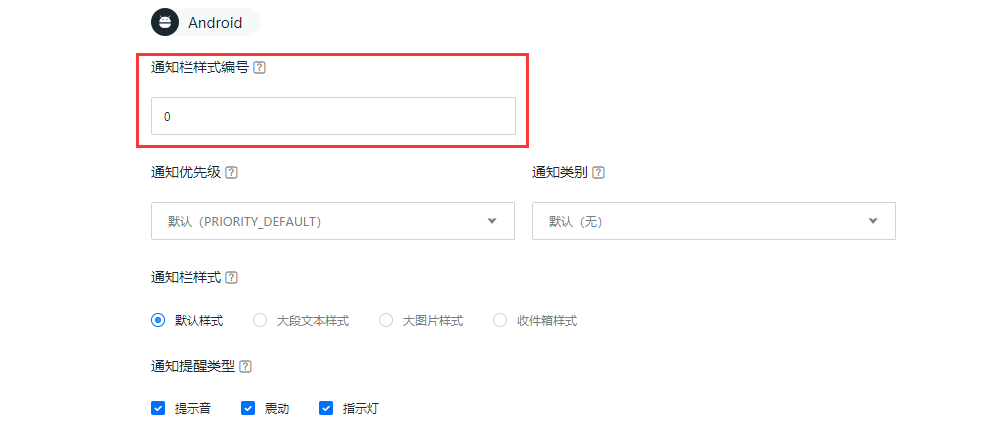Android SDK 进阶教程
自定义通知栏样式教程
关于自定义通知栏样式
JPush 通知推送到客户端时,默认使用手机的默认设置来显示通知栏,包括铃声、震动等效果。
如果开发者想要达到如下的效果,则需要使用“自定义通知栏样式”功能:
- 通知栏样式使用与默认不一样的设置,比如想要控制:
- 铃声、震动
- 显示图标
- 替换默认的通知栏样式。
推送消息指定通知栏样式编号
通知栏样式在服务器端向下推送时,只体现为一个编号(数字)。
推送通知的样式编号,应该是在客户端做了自定义通知栏样式设置的。
如果通知上的样式编号,在客户端检查不存在,则使用默认的通知栏样式。
不使用自定义通知栏样式时,此编号默认为 0。如需使用自定义的通知栏样式,编号应大于 0 小于 1000。先在客户端调 API 设置通知栏样式,推送设置 Builder ID 值即可在收到消息时得到对应的样式效果。
调 API 进行推送时,在 Notification - Android 属性下设置 builder_id 值
在 Portal 上发送通知时,首先选择推送平台为 Android,然后展开“可选设置”,开发者可指定当前要推送的通知的样式编号。如下图所示:

客户端设置通知栏样式
自定义的通知栏样式,是在客户端进行设置的。请参考 通知栏样式定制 API 来看所支持的功能。
自定义通知栏样式设计
- 有个 PushNotificationBuilder 概念,开发者使用 setPushNotificationBuilder 方法为某种类型的 PushNotificationBuilder 指定编号。
- setPushNotificationBuilder 可以在 JPushInterface.init() 之后任何地方调用,可以是开发者应用的逻辑来触发调用,或者初始化时调用。
- 只需要设置一次,JPush SDK 会记住这个设置。在下次收到推送通知时,就根据通知里指定的编号来找到 PushNotificationBuilder 来展现、执行。
API - setDefaultPushNotificationBuilder 设置默认
此 API 改变默认的编号为 0 的通知栏样式。
API - setPushNotificationBuilder 指定编号
此 API 为开发者指定的编号,设置一个自定义的 PushNotificationBuilder(通知样式构建器)。
Example - 基础的 PushNotificationBuilder
定制声音、震动、闪灯等 Notification 样式。
BasicPushNotificationBuilder builder = new BasicPushNotificationBuilder(MainActivity.this);
builder.statusBarDrawable = R.drawable.jpush_notification_icon;
builder.notificationFlags = Notification.FLAG_AUTO_CANCEL
| Notification.FLAG_SHOW_LIGHTS; //设置为自动消失和呼吸灯闪烁
builder.notificationDefaults = Notification.DEFAULT_SOUND
| Notification.DEFAULT_VIBRATE
| Notification.DEFAULT_LIGHTS; // 设置为铃声、震动、呼吸灯闪烁都要
JPushInterface.setPushNotificationBuilder(1, builder);
定制带按钮的 Notification 样式(3.0.0 及以上版本 sdk 才支持该样式,且该样式在某些与 Android 原生系统有差异的机型上无法正常显示)。
MultiActionsNotificationBuilder builder = new MultiActionsNotificationBuilder(PushSetActivity.this);
//添加按钮,参数(按钮图片、按钮文字、扩展数据)
builder.addJPushAction(R.drawable.jpush_ic_richpush_actionbar_back, "first", "my_extra1");
builder.addJPushAction(R.drawable.jpush_ic_richpush_actionbar_back, "second", "my_extra2");
builder.addJPushAction(R.drawable.jpush_ic_richpush_actionbar_back, "third", "my_extra3");
JPushInterface.setPushNotificationBuilder(2, builder);
Example - 高级自定义的 PushNotificationBuilder
基于基础的 PushNotificationBuilder,可进一步地定制 Notification 的 Layout。
这里作为 example 的 customer_notitfication_layout 在我们的 example 项目的 /res/layout/ 下可以找到。你完全可以用自己的 layout。
CustomPushNotificationBuilder builder = new
CustomPushNotificationBuilder(MainActivity.this,
R.layout.customer_notitfication_layout,
R.id.icon,
R.id.title,
R.id.text,
R.id.time);
// 指定定制的 Notification Layout
builder.statusBarDrawable = R.drawable.your_notification_icon;
// 指定最顶层状态栏小图标
builder.layoutIconDrawable = R.drawable.your_2_notification_icon;
// 指定下拉状态栏时显示的通知图标
JPushInterface.setPushNotificationBuilder(2, builder);
通知栏样式定义不符合要求?
以上提供的自定义通知栏样式的功能是有限的。比如:Android SDK 4.0 以后的 Notification 支持指定 Style ,而这种复杂的通知样式定义 JPush SDK 还未有支持。
或者你想要自定义的复杂的通知样式,但不愿意使用上述高级的自定义通知栏定制功能。
建议不要使用 JPush 提供的通知功能,而使用自定义消息功能。
即:推送自定义消息到客户端后,App 取到自定义消息全部内容,然后 App 自己来写代码做通知的展示。请参考文档:通知 vs. 自定义消息。
通知 vs 自定义消息
极光推送包含有通知与自定义消息两种类型的推送。本文描述他们的区别,以及建议的应用场景。
两者的区别 - 功能角度
通知
通知(Notification),指在手机的通知栏(状态栏)上会显示的一条通知信息。这是 Android / iOS 的基本功能。
通知主要用于提示用户。一条通知,简单的填写纯文本的通知内容即可。
应用加上通知功能,有利于提高应用的活跃度。
自定义消息
自定义消息不是通知,默认不会被 SDK 展示到通知栏上,极光推送仅负责透传给 SDK。其内容和展示形式完全由开发者自己定义。
自定义消息主要用于应用的内部业务逻辑和特殊展示需求。
两者的区别 - 开发者使用角度
通知
简单场景下的通知,用户可以不写一行代码,而完全由 SDK 来负责默认的效果展示,以及默认用户点击时打开应用的主界面。
JPush Android SDK 提供了 API 让开发者来定制通知栏的效果,请参考:自定义通知栏样式教程;也提供了接收推送消息 Receiver 让你来定制在收到通知时与用户点击通知时的不同行为。
自定义消息
SDK 不会把自定义消息展示到通知栏。所以调试时,需要到日志里才可以看到服务器端推送的自定义消息。
自定义消息一定要由开发者写 接收推送消息 Receiver 来处理收到的消息。
注意:
当自定义消息内容 msg_content 为空时,SDK 不会对消息进行广播,使得 App 无法接收到推送的消息,因此建议在使用自定义消息推送时添加内容。
使用通知
请参考以下示例代码。
public class MyReceiver extends BroadcastReceiver {
private static final String TAG = "MyReceiver";
private NotificationManager nm;
@Override
public void onReceive(Context context, Intent intent) {
if (null == nm) {
nm = (NotificationManager) context.getSystemService(Context.NOTIFICATION_SERVICE);
}
Bundle bundle = intent.getExtras();
Logger.d(TAG, "onReceive - " + intent.getAction() + ", extras: " + AndroidUtil.printBundle(bundle));
if (JPushInterface.ACTION_REGISTRATION_ID.equals(intent.getAction())) {
Logger.d(TAG, "JPush 用户注册成功");
} else if (JPushInterface.ACTION_MESSAGE_RECEIVED.equals(intent.getAction())) {
Logger.d(TAG, "接受到推送下来的自定义消息");
} else if (JPushInterface.ACTION_NOTIFICATION_RECEIVED.equals(intent.getAction())) {
Logger.d(TAG, "接受到推送下来的通知");
receivingNotification(context,bundle);
} else if (JPushInterface.ACTION_NOTIFICATION_OPENED.equals(intent.getAction())) {
Logger.d(TAG, "用户点击打开了通知");
openNotification(context,bundle);
} else {
Logger.d(TAG, "Unhandled intent - " + intent.getAction());
}
}
private void receivingNotification(Context context, Bundle bundle){
String title = bundle.getString(JPushInterface.EXTRA_NOTIFICATION_TITLE);
Logger.d(TAG, " title : " + title);
String message = bundle.getString(JPushInterface.EXTRA_ALERT);
Logger.d(TAG, "message : " + message);
String extras = bundle.getString(JPushInterface.EXTRA_EXTRA);
Logger.d(TAG, "extras : " + extras);
}
private void openNotification(Context context, Bundle bundle){
String extras = bundle.getString(JPushInterface.EXTRA_EXTRA);
String myValue = "";
try {
JSONObject extrasJson = new JSONObject(extras);
myValue = extrasJson.optString("myKey");
} catch (Exception e) {
Logger.w(TAG, "Unexpected: extras is not a valid json", e);
return;
}
if (TYPE_THIS.equals(myValue)) {
Intent mIntent = new Intent(context, ThisActivity.class);
mIntent.putExtras(bundle);
mIntent.setFlags(Intent.FLAG_ACTIVITY_NEW_TASK);
context.startActivity(mIntent);
} else if (TYPE_ANOTHER.equals(myValue)){
Intent mIntent = new Intent(context, AnotherActivity.class);
mIntent.putExtras(bundle);
mIntent.setFlags(Intent.FLAG_ACTIVITY_NEW_TASK);
context.startActivity(mIntent);
}
}
}
使用自定义消息
使用自定义消息,在客户端 App 里一定要写代码,去接受 JPush SDK 的广播,从而取得推送下来的消息内容。具体请参考文档:接收推送消息 Receiver。
以下代码来自于推聊。
public class TalkReceiver extends BroadcastReceiver {
private static final String TAG = "TalkReceiver";
private NotificationManager nm;
@Override
public void onReceive(Context context, Intent intent) {
if (null == nm) {
nm = (NotificationManager) context.getSystemService(Context.NOTIFICATION_SERVICE);
}
Bundle bundle = intent.getExtras();
Logger.d(TAG, "onReceive - " + intent.getAction() + ", extras: " + AndroidUtil.printBundle(bundle));
if (JPushInterface.ACTION_REGISTRATION_ID.equals(intent.getAction())) {
Logger.d(TAG, "JPush 用户注册成功");
} else if (JPushInterface.ACTION_MESSAGE_RECEIVED.equals(intent.getAction())) {
Logger.d(TAG, "接受到推送下来的自定义消息");
// Push Talk messages are push down by custom message format
processCustomMessage(context, bundle);
} else if (JPushInterface.ACTION_NOTIFICATION_RECEIVED.equals(intent.getAction())) {
Logger.d(TAG, "接受到推送下来的通知");
receivingNotification(context,bundle);
} else if (JPushInterface.ACTION_NOTIFICATION_OPENED.equals(intent.getAction())) {
Logger.d(TAG, "用户点击打开了通知");
openNotification(context,bundle);
} else {
Logger.d(TAG, "Unhandled intent - " + intent.getAction());
}
}
private void processCustomMessage(Context context, Bundle bundle) {
String title = bundle.getString(JPushInterface.EXTRA_TITLE);
String message = bundle.getString(JPushInterface.EXTRA_MESSAGE);
if (StringUtils.isEmpty(title)) {
Logger.w(TAG, "Unexpected: empty title (friend). Give up");
return;
}
boolean needIncreaseUnread = true;
if (title.equalsIgnoreCase(Config.myName)) {
Logger.d(TAG, "Message from myself. Give up");
needIncreaseUnread = false;
if (!Config.IS_TEST_MODE) {
return;
}
}
String channel = null;
String extras = bundle.getString(JPushInterface.EXTRA_EXTRA);
try {
JSONObject extrasJson = new JSONObject(extras);
channel = extrasJson.optString(Constants.KEY_CHANNEL);
} catch (Exception e) {
Logger.w(TAG, "Unexpected: extras is not a valid json", e);
}
// Send message to UI (Webview) only when UI is up
if (!Config.isBackground) {
Intent msgIntent = new Intent(MainActivity.MESSAGE_RECEIVED_ACTION);
msgIntent.putExtra(Constants.KEY_MESSAGE, message);
msgIntent.putExtra(Constants.KEY_TITLE, title);
if (null != channel) {
msgIntent.putExtra(Constants.KEY_CHANNEL, channel);
}
JSONObject all = new JSONObject();
try {
all.put(Constants.KEY_TITLE, title);
all.put(Constants.KEY_MESSAGE, message);
all.put(Constants.KEY_EXTRAS, new JSONObject(extras));
} catch (JSONException e) {
}
msgIntent.putExtra("all", all.toString());
context.sendBroadcast(msgIntent);
}
String chatting = title;
if (!StringUtils.isEmpty(channel)) {
chatting = channel;
}
String currentChatting = MyPreferenceManager.getString(Constants.PREF_CURRENT_CHATTING, null);
if (chatting.equalsIgnoreCase(currentChatting)) {
Logger.d(TAG, "Is now chatting with - " + chatting + ". Dont show notificaiton.");
needIncreaseUnread = false;
if (!Config.IS_TEST_MODE) {
return;
}
}
if (needIncreaseUnread) {
unreadMessage(title, channel);
}
NotificationHelper.showMessageNotification(context, nm, title, message, channel);
}
// When received message, increase unread number for Recent Chat
private void unreadMessage(final String friend, final String channel) {
new Thread() {
public void run() {
String chattingFriend = null;
if (StringUtils.isEmpty(channel)) {
chattingFriend = friend;
}
Map<String, String> params = new HashMap<String, String>();
params.put("udid", Config.udid);
params.put("friend", chattingFriend);
params.put("channel_name", channel);
try {
HttpHelper.post(Constants.PATH_UNREAD, params);
} catch (Exception e) {
Logger.e(TAG, "Call pushtalk api to report unread error", e);
}
}
}.start();
}
}


